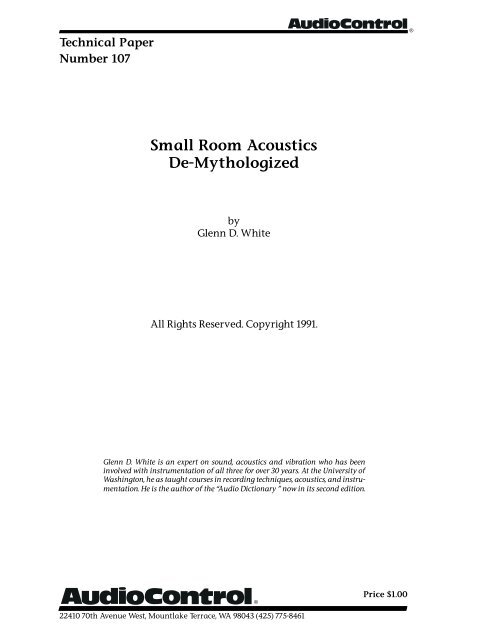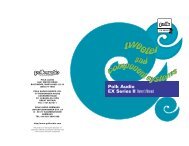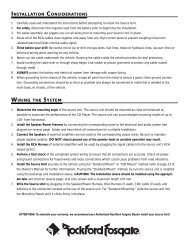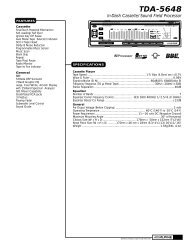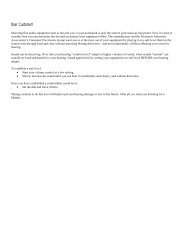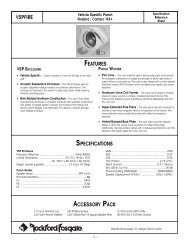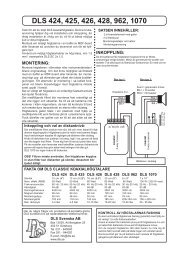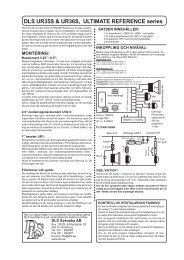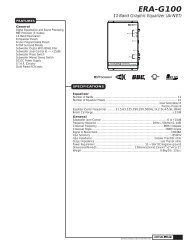Small Room Acoustics De-Mythologized - Eporia
Small Room Acoustics De-Mythologized - Eporia
Small Room Acoustics De-Mythologized - Eporia
You also want an ePaper? Increase the reach of your titles
YUMPU automatically turns print PDFs into web optimized ePapers that Google loves.
Technical PaperNumber 107®<strong>Small</strong> <strong>Room</strong> <strong>Acoustics</strong><strong>De</strong>-<strong>Mythologized</strong>byGlenn D. WhiteAll Rights Reserved. Copyright 1991.Glenn D. White is an expert on sound, acoustics and vibration who has beeninvolved with instrumentation of all three for over 30 years. At the University ofWashington, he as taught courses in recording techniques, acoustics, and instrumentation.He is the author of the “Audio Dictionary ” now in its second edition.®Price $1.0022410 70th Avenue West, Mountlake Terrace, WA 98043 (425) 775-8461
®<strong>Small</strong> <strong>Room</strong> <strong>Acoustics</strong> <strong>De</strong>-<strong>Mythologized</strong>It is certainly no surprise that there are great differences in the perceived sonic qualities ofsmall listening rooms compared to large auditoriums. But it is not so easy to physicallycharacterize, or even accurately describe, what these differences are. And once thesedifferences are more completely understood, how can this understanding help the seriousrecorded music listener to optimize his listening environment? Several questions come tomind: Can a small listening room be made to sound like a concert hall? Should the listeningroom be “dead” or “live”? Can the listening room acoustics improve on the acousticsof the original recording? Where should the loudspeakers be placed? Where should thelistener sit? Would electrical equalization benefit the sound system? If so, how should thisequalization be adjusted for optimum effect?In an attempt to answer these questions, we will first study the behavior of sound in realrooms and find out how reverberation, echoes, standing waves, resonances, and diffusioncome about. We will look into the question of how these objective characteristics of asound field translate into subjective impressions with which we are familiar. Then we willlook at how the architecture and materials of which a room is made effect the objective,and thus subjective acoustics. Next, we will consider the medium of recorded music andwill investigate the philosophical differences in various styles of recording and music.Finally, we will try to rationally apply this information to help in the design, or improvement,of a listening environment for recorded music.Sound Waves, Sound Pressure, and Sound PowerSound existing at a point in space can bedefined as a variation in atmosphericpressure at that point. A sound source,such as a small pulsating sphere surroundedby air, radiates energy into theair in all directions equally, and this isdefined as a free field condition. Seefigure 1. The source S radiates soundenergy at a rate called the sound power,measured in acoustic watts. Sound poweris defined as energy per unit time, just asany power is defined. The source Scauses an atmospheric pressure variationto occur at point P1, at a distance of oneunit from the source. This pressurevariation is defined as the sound pressure Figure 11
®at that point. All points on an imaginary sphere around the source at this same distancewill have the same sound pressure. The energy from the source is spreading out in spaceover ever expanding spheres at the speed of sound, or about 11 feet per second. A shorttime later, the sound will have reached point P2 at a distance of 2 units from the source.At this time, the energy has spread uniformly on a sphere twice as large as was the case atpoint P1. The area of this larger sphere is 4 times as large as the area of the smallersphere, so its strength, or its intensity, will be one-fourth as much. In other words, foreach doubling of distance from a source, the sound pressure falls by a factor of 4. This is aconsequence of the geometry of space, and is called the Inverse Square Law. Light andradio wave radiation also obey it.Because the speed of sound is not infinite, each frequency of pressure variation will beassociated with a wavelength. If the speed of sound is S, the frequency of the sound is F,and the wavelength is W, then they are related by this equation:S = FWThus, the higher the frequency, the shorter the wavelength and vice versa. Figure 2 plotsthe approximate frequency and wavelength of audible sounds. Note that low frequencyhave quite long wavelengths, in many cases longer than the listening rooms in which wewant to hear these sounds. Note also that the highest frequencies have very short wavelengths.These values are very important, as we shall see shortlyFigure 22
®The Behavior of Sound in an EnclosureFor the moment, we will forget about wavelength and frequency, and consider sound in aroom from an energy flow standpoint.A sound source in a room generates a sound field in the room which varies in character atdifferent places in the room, and it is convenient to define several descriptors of this soundfield. Locations near the sound source are said to be in the near field of the source. In thenear field, the sound is wholly determined by the source itself. A little farther from thesource, the sound field begins to be effected by the medium and surroundings. The part ofthe sound field outside the near field is called the far field. Also, the far field is convenientlydivided into regions called the free field and the reverberant field. (There is anotherpart of the sound field, very close to the room boundaries, which is sometimes called thefar-out field.)Before we look at the differences between these parts of the sound field in a room weneed to define a quantity called the sound pressure level, or SPL. To do this, we have tointroduce the concept of the decibel, or dB. It is quite likely that the dB has caused moreconfusion in people’s minds than any other parameter. The following treatment of it isnecessarily brief and not comprehensive, but should provide a working knowledge of SPLmeasured in dB. Of course, decibels are used in acoustics in many other ways as well.As we have seen, the sound pressure is defined as the variation in atmospheric pressurecaused by the existence of a sound. The sound pressure level is defined as the soundpressure measured as the number of decibels (dB) above 20 micropascals. The dB(SPL) isdefined as 20 times the common logarithm of the sound pressure ratio between twosounds. The Pascal is the metric unit of pressure, and 20 micropascals represents thesmallest sound pressure that an average healthy human ear can hear at 1000 Hz.Simply put, the decibel scale is proportional to the logarithm of the actual sound pressure,so equal numbers of dB represent equal ratios of sound pressures. For instance, a doublingof sound pressure is represented as a 6 dB increase, and a four-fold increase in soundpressure is a 12 dB increase. One dB(SPL) represents about a 12 percent change in soundpressure, and is close to the smallest change in pressure that a human ear can detect.These are good rules of thumb which will be helpful if committed to memory. Because ofthe complex and very non-linear way in which sound is processed in our hearing mechanism,a six dB increase in level does not cause a doubling of the loudness of a sound. Ittakes an increase of almost 10 dB to double the loudness of a sound. Incidentally, SPL isthe quantity measured by all standard sound level meters.From this, we see that the inverse square law can be described simply by saying that eachdoubling of distance from a sound source will result in a 6 dB decrease in SPL, providedthe source is radiating into a free field, with no nearby reflectors of sound.Getting back to the sound field in a room (figure 3), the near field is that part of the sound3
®field which exists in the immediate vicinity of a sound source and it is the space wheresound is not radiating out in spherical waves. Its extent is usually about equal to thelongest dimension of the source but this varies widely depending on the geometry of thesource. It may be less than this for low frequencies. The extent of near field is frequencydependent, but in a complex way. It is generally impossible to make meaningful SPLmeasurements in the near field, except in special cases such as certain loudspeakers whichare designed to simulate point sources.The free field exists farther from the source, and is defined as that space where the inverseFigure 3square law is obeyed, at least within acceptable limits. Thus in the free field, the SPL willdecrease by 6 dB for each doubling of distance from the source. The sounds reflectedfrom the walls are not adding significantly to the measured SPL, and meaningful andrepeatable SPL measurements can be made. This is the region where almost all loudspeakerfrequency response measurements are carried out. The extent of the free field isgenerally highly frequency dependent, always being farther at higher frequencies. The freefield is also the best place for a listener to position himself for listening to music reproducedvia loudspeakers.It is important to realize that the free field around a loudspeaker depends greatly on the4
®directional characteristics of the loudspeaker. A highly directional speaker such as a highfrequencyhorn will have a larger free field than will a more nearly omnidirectional speakersuch as a dome tweeter or a small woofer.As we go farther from the source beyond the free field, we enter the reverberant field,where the sound is more diffuse and homogeneous rather than coming from a particulardirection. The SPL in a reverberant field is constant at varying distances from the source.In a true reverberant field the net energy flow through any point is zero; i.e. the energy isarriving randomly and uniformly from all directions at once, providing no clue as to wherethe source of the sound is located. A perfectly diffuse sound field is not possible to achievein practice because of such disturbing factors as stationary, or “standing” waves, as weshall see.The boundary between the free and reverberant field around a loudspeaker is called the“critical distance”, and varies with frequency and the directionality of the speaker. It is theplace where the direct sound from the speaker and the reverberant sound are equallystrong.It is possible in some rooms to have a condition where there is no free field at all. Thereverberant field is dominant all the way up to the near field of the source. This is called areverberation chamber, and is used for special test purposes - never for listening to music.It is also possible to build a room which has essentially no reverberant field, and the freefield extends all the way to the room boundaries. This is called an “anechoic chamber”,and also is used for testing, but not for music listening.If the walls of a room are quite reflective, the sound pressure will increase close to theboundaries. This is because the incident pressure adds to the reflected pressure, and in thecase of a perfect reflector, the pressure at the surface would be double the free fieldpressure at that point. In other words, the SPL will be 6 dB higher at the surface of aperfect reflector. The pressure increase extends out from the wall almost a half wavelength,so this effect is also frequency dependent. This part of the sound field is sometimescalled the far-out field, and is not generally used for making SPL measurements.In any room, the reverberation time affects the location of the free and reverberant fields.Reverberation time is defined as the time it takes for a sound to decay by 60 dB after thesource of the sound is cut off. This sounds on the surface like a simple measurement, but itcan be highly complex. The only situation where reverberation behaves in a predictablemanner is where the reverberant field is truly diffuse, or almost completely random in itsdirection. Real rooms suffer from lack of diffusion due to the existence of standing wavesand “room resonances”. These supplementary resonances distort the ideal shape of thereverberation level versus time curve, which would otherwise be a smoothly decayingstraight line. It is these resonances that complicate the art and science of loudspeakerplacement and equalization.Standing Waves and <strong>Room</strong> Resonances5
®Standing waves arise when two reflective surfaces on opposite sides of a room are paralleland a sound source is between them. At certain well-defined frequencies, the incidentsound wave at a surface will reflect back and interfere with itself causing a stationarypattern of low and high sound pressure levels. See figure 4.With perfectly reflecting walls, the minima would be zero sound pressure, or negativeinfinity dB SPL, but ordinary walls do not cause complete cancellation, and the minima areonly down about 10 to 30 dB. Note that a set of standing waves will exist which areintegral multiples of the frequency where one half wavelength is equal to the wall spacing.The behavior of parallel walls is similar to what happens in an organ pipe. These standingwaves are also known as room resonances. A good familiar example of a strong standingwave is the tiled shower stall. If the height is 7 feet, the lowest frequency which will bereinforced at the ceiling and floor is about 80 Hz, which is within the fundamental frequencyrange of most male voices. The nearby side walls keep the sound energy confinedin the stall, increasing the loudness, and the position of the head near the ceiling means thepressure increase due to the standing wave is heard. This strong reinforcement of thelower voice range is a powerful inducement for some people to sing!A rectangular room with smooth hard surfaces will have three sets of standing waves, andif the dimensions of the room are equal (a cubical room), all the resonances will overlapand reinforce each other. If the dimensions are commensurate (having a least commondenominator), then some of the resonances of the three sets will have the same frequencies,and will reinforce each other also. This increases the non-uniformity of distribution ofsound in the room, and for this reason non-commensurate dimensions are desired formusic listening rooms.Note from figure 4 that all standing wave patterns have maxima at the room boundaries.Note also that if one listens at any location where there is a minima, that particular standingwave will not be heard, or at least will be heard at a much lower level.Standing waves in rooms are a form of room resonance, and their location and frequencyare precisely determined by the room dimensions, not by the source of the sound. Their“strength”, or magnitude depends on the sound absorption characteristics of the roomboundaries. If the boundaries are very absorbent, the standing waves will be very weak,and probably not noticeable at all. On the other hand, if the boundaries are very reflective,such as concrete or smooth plaster, the standing waves will be very prominent. Mostcommon surfaces in music listening rooms have significant absorption, especially at thehigher frequencies. For this reason, standing waves at high frequencies are seldom if ever aproblem. At low frequencies, however, two things conspire to make standing waves veryannoying to the music listener. One is the fact that the wavelengths are fairly long. Forinstance, at 100 Hz, the wavelength is about 10 feet, and standing wave maxima are thusabout 5 feet apart. Contrast this to 10 kHz, whose wavelength is about an inch, withstanding wave maxima spaced only about a half-inch apart. The widely-space maxima andminima of low-frequency standing waves are what give a small bad room its non uniformity.6
®Figure 4 - Standing waves between two parallel surfacesNow we can begin to define the difference between large and small rooms. In a large room(smallest dimension of 50 feet or so), the standing waves will be multiples of very lowfrequencies. Two walls 50 feet apart will have a lowest resonant frequency of about 11Hz, and standing waves can exist at all multiples of this frequency. they are thus very closetogether by the time they get up into the audible range, and even though they are extremelynumerous, they tend to simply blend together fairly smoothly. This is the reasonlarge rooms always sound smoother and more uniform than small rooms. Of course, large7
®rooms can have plenty of problems of their own. For example, another acoustical problemcaused by parallel surfaces is the phenomenon of “flutter echoes”. If the spacing betweenthe surfaces is quite large, usually about 25 feet or more, a sharp transient sound producedbetween them will reflect off one and then the other giving a series of echoes whichgradually die away. This can be annoying, and usually is worse in fairly large rooms.There are other acoustical problems associated with rooms besides standing waves. Forinstance, the corner where two walls and a floor or ceiling meet (geometrically, this iscalled a “right tricorner”), will reflect sound of any frequency directly back in the directionfrom whence it arrived. (This is the principle used in radar reflectors and also the red lightreflectors found on many bicycles and cars.) Two right tricorners in a room, especially ifthey are diagonally opposite each other, will give rise to standing waves just like parallelsurfaces will. Also, in large rooms, a right tricorner will give an echo, regardless of thelocation of the sound source. If the angles meeting at the corner are not right angles, thetricorner does not reflect back in the same direction, and therefore architects are alwaysadmonished to avoid right tricorners in music rooms, regardless of their size.Also, because of the huge numbers of possible standing wave patterns in large rooms, theytend to have a much greater degree of diffusion in the reverberant field than do smallrooms with their fewer and more widely-spaced standing wave frequencies. This diffusionlends a sense of “envelopement” in the sound field, and also provides a sensation ofsmoothness and uniformity to music. To achieve this in a small room is nearly impossible,for if the absorption by the surfaces is sufficient to prevent standing waves from becomingobjectionable, the reverberation time will be so short that the room will sound “dead”, andlive music will not be appreciated, especially by the musicians. In order to have somesound diffusion in its reverberation, small rooms should not have parallel surfaces or righttricorners, and this can be attained in specially designed music rooms. But a living room ina residence is usually another matter, as is quite obvious.Types of RecordingsBefore we look at the effect of reproduced music in small rooms, it will be instructive toconsider the characteristics of various types of recorded music. Consider a recording of alarge orchestra. Typically the recording will have been made in a large auditorium, onepresumably selected for its fine acoustics. Such a room will have significant reverberation,and at least some of this reverberation will be recorded along with the direct sound fromthe orchestra. How much “room sound” is captured by the recording is of course up to therecording engineer, but in any case it will be significant. The intent of such a recording isto provide the listener with the illusion of being in the large room with the orchestra. It isnot intended to try to re-create the orchestra in the listener’s living room. For this type ofrecording, it can be argued that a dead listening room is desired, for the correct acousticalambience is in the recording, and should not be compromised by the addition of theambience of the listening room, for the listening room acoustics will always be less desirableas we have seen.8
®On the other hand, a recording of a very small ensemble, or in the extreme a soft soloinstrument such as a Spanish guitar, need not have the ambience of a vast hall recordedwith it. To preserve the intimacy inherent in the guitar’s music requires relatively closemike placement and the necessary reduced amount of the recording room environment.(However, it is a grave mistake to make such a recording in a small reverberant room, forthe boundary reflections will be relatively strong and will be recorded, even with fairlyclose miking. In general, the larger the recording room, the better.) This recording, ifreproduced in a small dead room will also sound lifeless, and some reflected sound isdesirable at the listening position. It can probably be said that no one room will be idealfor listening to large orchestras and small musical groups; one has to compromise in onedirection or the other.It should be mentioned in passing that the complex sound systems which emulate largerooms by adding reverberation and supplying synthetic side wall reflections from supplementaryspeakers require non-reverberant listening rooms. What a listener hears is alwaysthe summation of the characteristics of his listening room and the ambience of the soundfield provided by the sound system. In no way can any sound system cancel out the acousticsof the listening room.Having said this, we must hastily point out that it is possible to optimize the listeningconditions in a room by seeing to it that the sound system will excite the undesirablecharacteristics of the room as little as possible.Frequency ResponseThe frequency response of a sound system can be defined in several ways. For instance, asystem consisting of an amplifier connected to a loudspeaker in an anechoic chamber canbe said to have a flat frequency response if the SPL produced at a distance of 1 meter infront of the loudspeaker is uniform at all frequencies when a variable frequency sine waveis input to the amplifier. This is sometimes called the free-field response of the speaker,and many manufacturers measure their speakers this way.Another way to measure frequency response is to place the speaker in a reverberationchamber and put the measurement microphone in the diffuse or reverberant field. Theresulting curve is called the power response of the speaker, and some manufacturersmeasure loudspeakers this way also. A speaker with flat power response will not necessarilyhave a flat free-field response, for the power response integrates all the energy producedby the speaker in all directions, while the free-field response measures the soundprojected directly forward. If the speaker was completely omnidirectional at all frequencies,its power and free field responses would be the same. (This may or may not bedesirable, for an omnidirectional speaker tends to excite all the standing waves and resonancesof the room, while a directional speaker theoretically will excite only those resonanceswhich occur in the direction the sound is aimed. In practice, it is difficult if notimpossible to control accurately the directivity of a loudspeaker system over a widefrequency range. All systems tend to become omnidirectional at very low frequencies9
®because they are small compared to the wavelengths involved, and to be quite directionalat high frequencies because they are large compared to these smaller wavelengths. Referringto figure 5, the directional loudspeaker can represent a horn tweeter or a planarspeaker such as an electrostatic. The non-directional speaker could be a dome tweeter, butalso represents the situation for low frequencies radiated by almost any woofer. Thereforeit is difficult to control poor room acoustics by using directional speakers because most ofthe resonance problems in rooms occur at low frequencies.)One might think that a listener would find a flat free-field response to be ideal, and thismight be true in most rooms if he listened at one meter from the speaker. This of course isseldom desirable or possible. As the listener moves farther from the speaker, closer to thereverberant field of the room, the perceived frequency response changes, and always forDirectional LoudspeakerFigure 5Non-directional Loudspeakerthe worse. The speaker will excite various standing waves of the room depending onwhere it is located. If it is in a room corner, it will of necessity excite all the standingwaves. If it is placed out from the walls a few feet and not close to a corner it will selectivelyexcite those standing waves which have maxima near the speaker. (A sound sourcelocated at a minima of a standing wave will not excite that particular resonance verymuch. If the minima were truly a null, it would not be excited at all.) Therefore, thelocation of the speaker in the room has a great deal to do with how much energy it putsinto the room as a function of frequency.10
®In particular, the proximity to reflecting surfaces greatly affects the efficiency with whichlow frequencies are radiated. A corner location provides the most low-frequency energy,and a side wall location provides somewhat less, while a location away from walls providesthe least. Some loudspeakers are designed to be flat when in a corner or against awall, while others are designed for mounting away from these surfaces.Remember, however, the standing wave pattern in any room is determined by the roomdimensions only, and does not change if the speaker is moved around. Loudspeakerplacement can only affect the relative degree to which various resonances are excited.Also, for any given loudspeaker location, the perceived frequency response dependsgreatly on the location of the listener. If one is sitting near the maximum of any standingwave, that frequency will be accentuated. It follows that if a speaker is in a corner and thelistener is in the diagonally opposite corner, both will be at maxima for all standing waves,and the most efficient perceived low-frequency response will be attained. Such a listeningposition has many other disadvantages, however!Attacking The ProblemIt might seem that any listening situation could be corrected to have ideal frequencyresponse simply by applying corrective electrical equalization in the sound system. This,however, is an oversimplification. The perceived frequency response of a sound systemdepends strongly on the speaker location and the listener location. For one listener positionand speaker position, equalization can provide flat response for steady-state signals.The term “steady state” is important. Remember that standing waves are formed byreflections back and forth between parallel surfaces. It therefore takes a little time forthese standing waves to build up. The listener to a sound system, however, hears thedirect sound from the speaker first, before any reflections take place. This direct soundwill not be contaminated by standing waves, and if the loudspeaker has flat free-fieldresponse, after equalization, the first sound arriving at the listener will be uniform inresponse. Only later will the overall response take on the coloration caused by the roomitself. It so happens that the ear is particularly sensitive to the first sound it hears, andtends to judge a sound’s overall quality by the uniformity of the direct sound. Therefore,even though a large amount of equalization can correct for a very strong maximum orminimum from standing waves, the correction will be applied to the direct sound where itis not needed, and the timbre of the sound may be distorted. For this reason, equalizationmust be used carefully, and always must be adjusted by listening to the results and notrelying exclusively on instruments such as sound level meters to determine “flat” response.11
®Equalization for ImprovementProbably the best thing to do first to optimize the listening conditions of a sound system isto reduce standing waves and resonances as much as possible. Standing waves in a roomwill distort the natural shape of the reverberation curve, as in figure 6. Try to eliminatelarge parallel surfaces. Large pieces of furniture with irregular surfaces such as bookcasescan reduce standing waves by adding diffusion to the reflected sounds. Sound absorbingmaterials or structures can be applied in some cases, although low-frequency absorbers arenecessarily large. Flexible walls, such as sheetrock on steel studs are quite good at absorbinglow frequencies, especially if backed by damping material such as rock wool insulation.Draperies, if made of dense material, are effective at mid and high frequencies, butare not very good absorbers of very low frequencies. Carpets and overstuffed furniturehelp prevent the floor and ceiling from resonating. Of course a cathedral or sloping ceilingis much preferred, but not always practical. Avoid placing the listening position near hardreflecting surfaces. Then, experiment with speaker placement while listening at manylocations in the room, and try to establish the placement which provides the most uniformlow-frequency response, consistent with domestic harmony. The listening position canseldom be one precise location. Try to find a combination of speaker and listener positionsthat result in the least change in the sound.After these steps are taken, electrical equalization can be very beneficial. A suitablegraphic equalizer will be found to work well. In most rooms with standing wave problems,it will be found that the low frequencies will be the most troublesome, and that severalmaxima will be quite close together in frequency. At higher frequencies, it will be foundthat the resonances are blending together into a smoother overall response. For thisreason, the equalizer used should have narrower bands (i.e. one-third or one-half octave)at the lowest frequencies and need not be so narrow at mid and high frequencies. Thebroader the bands, or the more gentle the adjustments that can be used at mid and highfrequencies, the better the result the equalization will produce. The response will bemore uniform.12
®Figure 613
®A good way to perform the equalization is to use a CD or record with one-third octavebands of pink noise. This is especially convenient if a one-third octave graphic equalizer isin the system. A sound level meter can be used to detect the level. Then, adjust the equalizerfor uniform response with the microphone of the sound level meter at the listenerposition, always using the smallest amount of equalization. The knobs of the graphicequalizer should be as close to the “0” line as possible to avoid ripple in the overall responsecurve, as illustrated in figure 7. Though the better designed equalizers have less ofthis ripple. It is important to have a very smooth equalization curve at the mid and highfrequencies, without any abrupt peaks or dips. In the low-frequency range, fairly pronouncedpeaks and dips can be used without noticeable distortion of the direct sound.Don’t worry too much about minima in perceived loudness, for they are much less audiblein music listening than peaks, and if you correct an acoustical minima by adding a peak byequalization, the peak will show up strongly in the direct sound as discussed before. It isalso important that the highest frequencies should not be boosted to attain flat response atthe listener position; otherwise the system will sound excessively bright. The ideal systemresponse curve at the listener position depends on the size of the listening room, buttypically should roll off by about 6 dB at 15kHz. Be guided by your ears - they are a moresophisticated measurement tools than any instrument!In general, electrical equalization, correctly designed and applied, can make a room soundbetter. It can make a good room sound excellent, but will not make a bad room soundgreat.EQ settings at zeroFlat frequency responseEQ settings at +10dBFrequency response rippleFigure 714


